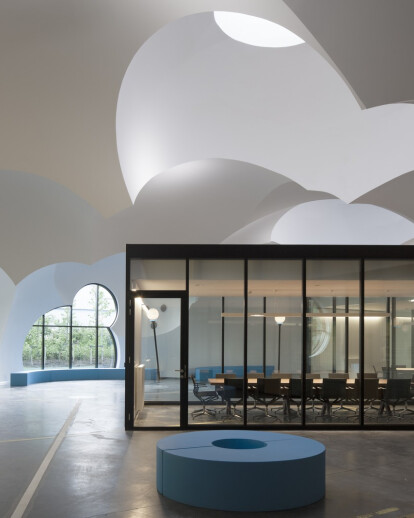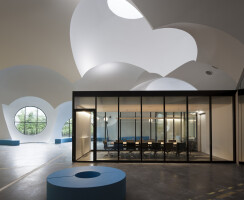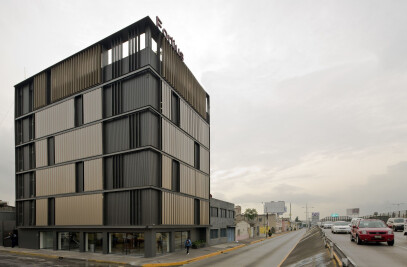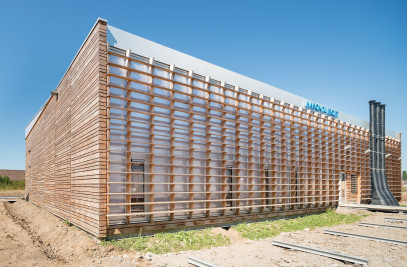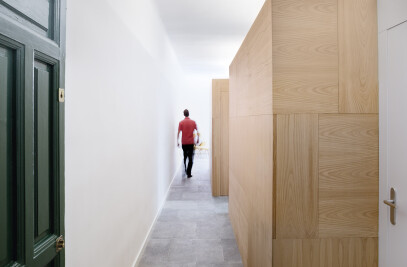OostCampus is the seat of civic, administrative and social services of an area in the heart of the countryside around Bruges (Brugse Ommeland), a beautiful landscape outlined by rows of trees and canals, punctuated by residential castles built along the centuries by wealthy merchants from the neighbouring Flemish town, and enriched with discrete industrial parks with high end technology companies like Siemens, Tyco, Entropia Digital, or EADS.
In 1977 four municipalities were grouped, Oostkamp, Hertsberge, Waardamme and Ruddervoorde, as a result of a national law that eliminated more than 300 municipalities across Belgium. They regrouped services, but the resulting facilities were scattered in various municipal buildings.
In 2006, the City acquired a 4 hectare plot of land with Coca-Cola facilities built in 1992, which had become obsolete. The plot, located 5 minutes walk from the centre of Oostkamp, 10 minutes by bike from the other townships, and near the exit of Highway E-40, offered the opportunity to regroup municipal services, optimizing synergies and building a common image.
In 2008 the Flemish Government Architecture Agency (Vlaams Bouwmeester) announced an open call for ideas to build OostCampus, with a slogan that paraphrases Magritte: "Ceci n'est pas ... een Administratief centrum”
The winning project, by the Madrid studio lead by Carlos Arroyo, opted for a radical re-use of the large industrial existing building, including foundations, floors, supporting structures, outer skin, insulation, waterproofing, and all recoverable services and equipment: power station, heating plant, water pipes, fire hoses, sewerage, and even parking area, fencing and access.
The reuse of the existing is a basic criterion of sustainability. The "gray energy" (energy used for the production of something) is often discarded or simply ignored. If we demolish an existing structure and build again, we will use more energy and resources than the most efficient of buildings can save in its life span.
To transform the vast industrial hall - with minimal footprint but maximum spatial result - Arroyo designs a sheltered interior public space, wrapped in a “luminous landscape of white clouds". Thin shells of GRG (gypsum and fibre) span the large space like huge soap bubbles. They are only 7 mm thick. The GRG is cast on bubble-shaped moulds on site, just like plaster and bandage around a broken arm; instead of cotton bandage, it is glass fibre mesh.
The building materials are simple and inexpensive, but are selected and used in such a way that you want to go and touch them. For cluster walls, simple boards are CNC carved to become sophisticated 3D damascene; some elements are finished with a felt made from recycled plastic bottles (PET); the floor is the existing industrial warehouse poli-concrete, with its lines of storage, on which the new signage is superimposed. The acoustics are carefully worked out, and so is the smell! The price per square meter building is one-third of the usual for comparable buildings.
Thermal comfort is achieved with minimum effort, thanks to the technique of the "thermal onion", as defined by the architects, which optimizes climate areas according to levels of access, and making use of the thermal inertia of the concrete slab.
Within this interior landscape, a set of modular clusters provides the administrative services and spaces, designed to facilitate the relationship between citizens and administration and to provide transparency. The Chamber Hall is in full sight in the middle of public space, the information is accessible, and you can even visualize the municipal website ...and physically enter it and talk to the person who is behind! This is a key issue in this project, responding to a wider strategy of the city, led by deputy mayor Jan Compernol, to work out and implement a new way to organize the administration in the community. It was managed through a series of workshops with all the employees, where everyone had their say.
During the basic design phase, six months were dedicated to the fine-tuning of the concept, to establish the right arrangement in terms of work flow, privacy, scale, growth potential, flexibility, maintenance, etc. The architects have developed a tool to facilitate this kind of dialog. They call it a "topogram", and it is a diagram of space requirements, conditions and connections that makes it easier to discuss space design with people who do not necessarily work with technical architectural drawings.
“It was an extremely rewarding process, with City, employees, citizens, experts and designers, learning from each other and developing a vision for a new kind of city government. Our design is the crystallization of this vision.” (C.A.)
OostCampus opened on June 15, 2012. Implementation of sustainability criteria with spectacular results has led reviewers to define the work of Carlos Arroyo as "lush sustainability” (duurzame exuberantie).
